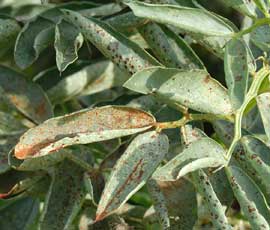Keep beans free from chocolate spot to boost yield

Controlling chocolate spot disease in winter beans is vital to boosting yields and profit margins, with a June fungicide spray at the start of the pod-filling stage seen as critical.
Wet weather diseases such as chocolate spot were common in bean crops in 2012, so fungicide-treated plots in trials at the Processors and Growers Research Organisation (PGRO) showed less disease and an increase in yield.
This was one of the first results to come out of season one of a four-year Optibean project to assess the best agronomic practices for growing beans, using three sites in eastern England.
PGRO’s Kerry Maguire tested three different spray timings in early, mid- and late season to control chocolate spot in winter beans using the fungicide Signum (boscalid + pyraclostrobin).
“The application in mid-June at the start of pod-filling appears to be critical for winter beans. There was less disease and therefore less effect on yield in spring beans,” she says.
Other work by the PGRO’s Stephen Belcher showed the late sowing of winter beans in the autumn led to less chocolate spot developing than with earlier sowings, but later drilling dates were likely to have an adverse effect on yield.
The four-year project is aimed at giving growers sound advice to make the most of the advantage of growing pulses, which the PGRO says needs no nitrogen fertiliser, while the legume crop leaves on average 40-50kg/ha of residual nitrogen, which can help to boost yields of a subsequent winter wheat crop by 1t/ha.
Trials looking at controlling aphids were inconclusive, as the wet weather of 2012 meant aphid numbers and therefore virus levels were low. Work continues to try to assess more accurately the nitrogen boost to a following crop.
In separate work, Ron Stobart at crop consultants NIAB TAG showed from his trials at Morley research station in Norfolk that there was a yield advantage of about 0.5t/ha in winter wheat following spring beans, which yielded 8.51t/ha, compared with a wheat crop after oilseed rape yielding 7.99t/ha.
He was also looking at the decline in yields of oilseed rape in very tight rotations, and the possible introduction of bean crops to stretch those rotations.
Comparing a very short wheat/oilseed rape/wheat rotation and one where oilseed rape appears only once every four or five years, he concluded: “Our findings suggest there is about a 12% yield loss going from long to short rotations in oilseed rape crops”.

